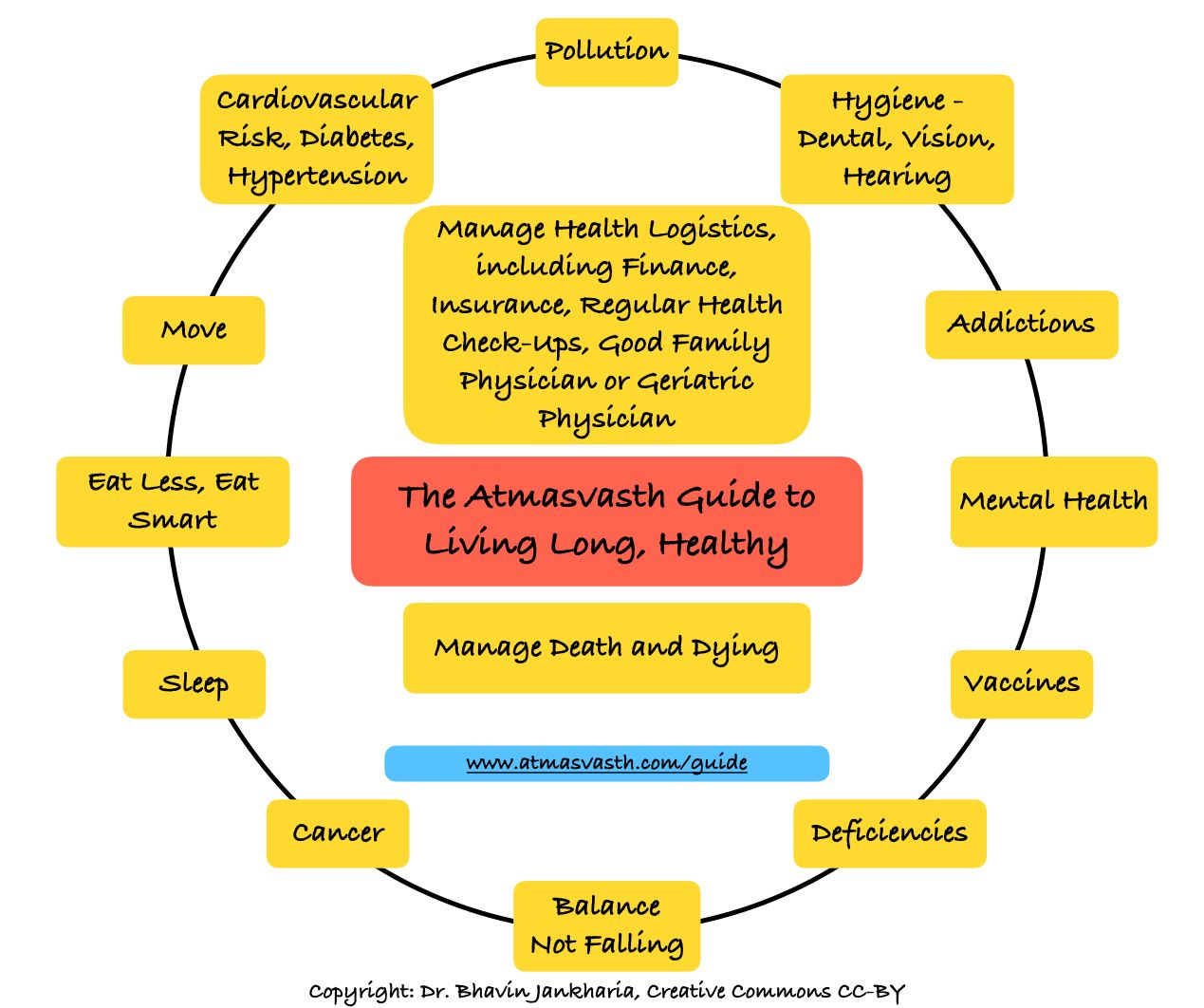Physical Activity Update - I (Blood Pressure, Diabetes, Cancers, Falls, Sleep, Dementia)
Updated data on the impact of physical activity on blood pressure, diabetes, sleep, cancers, falls and dementia

The Book - Kindle Version Now Available Worldwide

The Detailed 15-Point Guide to Live Long, Healthy

Audio
You can listen to the audio/podcast hosted on Soundcloud by clicking the Play button below within the browser itself. You can click here to access directly from your email.
Text
To get born, your body makes a pact with death,
and from that moment, all it tries to do is cheat—
Louise Gluck - A Slip of Paper
In the last 3 years, we have seen that “moving” improves healthspan and lifespan, helps with blood pressure control, improves white matter function, offsets the downsides of reduced sleep, reduces the rate of cognitive decline and the chance of falls and fractures.
It’s time for our physical activity updates…to see what new data has been published in 2023 and early 2024, since I last wrote and spoke about the benefits of physical activity.
Blood pressure
“Aerobic exercise training, dynamic resistance training, combined training, high-intensity interval training and isometric exercise training are all significantly effective in reducing resting systolic and diastolic blood pressure. Overall, isometric exercise training is the most effective mode in reducing both systolic and diastolic blood pressure.” This is from a meta-analysis of 270 randomized controlled trials [1], stressing that while any activity is good, strength training is perhaps better for blood pressure management and therefore a combined activity program including both aerobic and strength training works best.
Another study also using UK Biobank data [2] found that in 49060 patients with diagnosed high blood pressure, moderate physical activity (MPA) measured by accelerometers was significantly associated with all-cause mortality improvement of 34-54% (i.e people with high blood pressure lived longer if they were physically active).
Diabetes
A very interesting study using the UK Biobank data [3] showed that moderate to vigorous physical activity (MVPA) (i.e. 30-45 minutes of brisk walking per day or equivalent) measured by accelerometer was strongly associated with the development of diabetes (i.e. more active the person, less the chance of developing diabetes) including in those with the highest genetic risk of type 2 diabetes.
This means basically that irrespective of genetic risk, the more active you are, the less the chance of developing type 2 diabetes.
Cancers
Many of the papers that I have quoted in the last 3 years have shown that MVPA or vigorous physical activity (VPA) reduces all cause or even cancer specific mortality.
What I have not touched upon so far is the effect of PA on reducing the occurrence of cancer in the first place, because it is not easy to evaluate such cause and effect given that correlation does not imply causation. However, when papers on this subject start being published in high impact factor and high quality journals, maybe it is time to address this issue.
One thought-provoking study by Emmanuel Stamatikis and colleagues [4] in JAMA Oncology again looking at the UK Biobank evaluated 22398 people who said they were non-exercising, but then checked their accelerometer data for vigorous intensity and vigorous intermittent lifestyle physical activity (VILPA) and found that a minimum of 3.4 to 3.6 minutes of VILPA was associated with a 17-18% reduction in the incidence of cancer risk. By extension, this implies that those who exercise more are likely to have higher benefits, which was shown in a meta-analysis published in 2020 in JCO [5] that concluded that MVPA or VPA was associated with a reduction in cancers of the colon, breast, kidney, myeloma, liver and non-Hodgkin’s lymphoma.
Sleep
While optimal sleep of 7-9 hours is ideal, many people typically sleep shorter and a few, longer, which may have adverse health outcomes. In keeping with earlier research on this subject, another UK Biobank related study [6] found that MVPA or VPA attenuated the downsides of poor sleep, significantly, concluding that if for whatever reason you are not able to find 7 hours of sleep per day, being active can help reduce the deleterious effects of poor sleep.
Falls and Fractures
Not falling and not fracturing if you fall are critical components of our atmasvasth goal to live long, healthy.
An article by Wing Kwok and colleagues using data from the Australian Longitudinal Study on Women’s Health [7] showed that MVPA and MPA both are associated with a reduced incidence of falls and falls related fractures.
Cognitive Decline and Dementia
We have seen earlier that PA can reduce the rate of cognitive decline but this study from the US [8] evaluating 91298 patients with Alzheimer’s disease found that VPA of around 40 weekly minutes would reduce 12238 deaths per year, improving to 37710 deaths with a VPA of 140 weekly minutes.
What does this all mean for you and I? To repeat ad nauseum, PA is the “magic pill”, guaranteed to increase our healthspan and lifepsan. New data from 2023 and early 2024 clearly shows that MPA, MVPA and VPA can improve blood pressure control, blood sugar control, reduce the incidence of some forms of cancer, attenuate the downsides of poor sleep, reduce falls and falls related fractures and reduce deaths associated with dementia.
In the next post, I will look at more PA data on the number of steps, the amount of activity, the timing of the PA and the importance of strength training.
Footnotes:
1. Edwards JJ et al. Exercise training and resting blood pressure: a large-scale pairwise and network meta-analysis of randomised controlled trials. Br J Sports Med. 2023 Oct;57(20):1317-1326. doi: 10.1136/bjsports-2022-106503. Epub 2023 Jul 25. PMID: 37491419.
2. Xiang B, Zhou Y, Wu X, Zhou X. Association of Device-Measured Physical Activity With Cardiovascular Outcomes in Individuals With Hypertension. Hypertension. 2023 Nov;80(11):2455-2463. doi: 10.1161/HYPERTENSIONAHA.123.21663. Epub 2023 Sep 5. PMID: 37667966.
3. Luo M, Yu C, Del Pozo Cruz B, Chen L, Ding D. Accelerometer-measured intensity-specific physical activity, genetic risk and incident type 2 diabetes: a prospective cohort study. Br J Sports Med. 2023 Oct;57(19):1257-1264. doi: 10.1136/bjsports-2022-106653. Epub 2023 Jun 5. PMID: 37277158; PMCID: PMC10579175.
4. Stamatakis E et al. Vigorous Intermittent Lifestyle Physical Activity and Cancer Incidence Among Nonexercising Adults: The UK Biobank Accelerometry Study. JAMA Oncol. 2023 Sep 1;9(9):1255-1259. doi: 10.1001/jamaoncol.2023.1830. PMID: 37498576; PMCID: PMC10375384.
5. Matthews CE et al. Amount and Intensity of Leisure-Time Physical Activity and Lower Cancer Risk. J Clin Oncol. 2020 Mar 1;38(7):686-697. doi: 10.1200/JCO.19.02407. Epub 2019 Dec 26. PMID: 31877085; PMCID: PMC7048166.
6. Liang YY et al. Joint association of physical activity and sleep duration with risk of all-cause and cause-specific mortality: a population-based cohort study using accelerometry. Eur J Prev Cardiol. 2023 Jul 12;30(9):832-843. doi: 10.1093/eurjpc/zwad060. PMID: 36990109.
7. Kwok WS et al. Leisure-Time Physical Activity and Falls With and Without Injuries Among Older Adult Women. JAMA Netw Open. 2024 Jan 2;7(1):e2354036. doi: 10.1001/jamanetworkopen.2023.54036. PMID: 38294812; PMCID: PMC10831579.
8. López-Bueno R, Yang L, Stamatakis E, Del Pozo Cruz B. Moderate and vigorous leisure time physical activity in older adults and Alzheimer's disease-related mortality in the USA: a dose-response, population-based study. Lancet Healthy Longev. 2023 Dec;4(12):e703-e710. doi: 10.1016/S2666-7568(23)00212-X. PMID: 38042163.
Atmasvasth Newsletter
Join the newsletter to receive the latest updates in your inbox.



